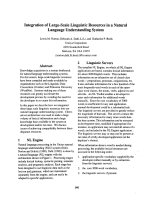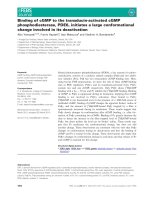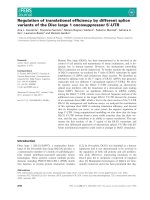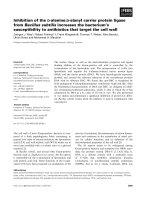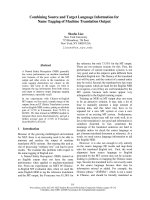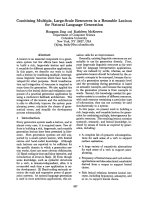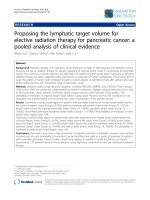Báo cáo khoa học: " Radiotherapy of large target volumes in Hodgkin''''s lymphoma: normal tissue sparing capability of forward IMRT versus conventional techniques" docx
Bạn đang xem bản rút gọn của tài liệu. Xem và tải ngay bản đầy đủ của tài liệu tại đây (1.98 MB, 10 trang )
Cella et al. Radiation Oncology 2010, 5:33
/>Open Access
RESEARCH
BioMed Central
© 2010 Cella et al; licensee BioMed Central Ltd. This is an Open Access article distributed under the terms of the Creative Commons
Attribution License ( which permits unrestricted use, distribution, and reproduction in
any medium, provided the original work is properly cited.
Research
Radiotherapy of large target volumes in Hodgkin's
lymphoma: normal tissue sparing capability of
forward IMRT versus conventional techniques
Laura Cella
1,2
, Raffaele Liuzzi
1,2
, Mario Magliulo
1
, Manuel Conson
2
, Luigi Camera
2
, Marco Salvatore
2
and
Roberto Pacelli*
1,2
Abstract
Background: This paper analyses normal tissue sparing capability of radiation treatment techniques in Hodgkin's
lymphoma with large treatment volume.
Methods: 10 patients with supradiaphragmatic Hodgkin's lymphoma and planning target volume (PTV) larger than
900 cm
3
were evaluated. Two plans were simulated for each patient using 6 MV X-rays: a conventional multi-leaf (MLC)
parallel-opposed (AP-PA) plan, and the same plan with additional MLC shaped segments (forward planned intensity
modulated radiation therapy, FPIMRT). In order to compare plans, dose-volume histograms (DVHs) of PTV, lungs, heart,
spinal cord, breast, and thyroid were analyzed. The Inhomogeneity Coefficient (IC), the PTV receiving 95% of the
prescription dose (V95), the normal tissue complication probability (NTCP) and dose-volume parameters for the OARs
were determined.
Results: the PTV coverage was improved (mean V95
AP-PA
= 95.9 and IC
AP-PA
= 0.4 vs. V95
FPIMRT
= 96.8 and IC
FPIMRT
= 0.31,
p ≤ 0.05) by the FPIMRT technique compared to the conventional one. At the same time, NTCPs of lung, spinal cord and
thyroid, and the volume of lung and thyroid receiving ≥ 30 Gy resulted significantly reduced when using the FPIMRT
technique.
Conclusions: The FPIMRT technique can represent a very useful and, at the same time, simple method for improving
PTV conformity while saving critical organs when large fields are needed as in Hodgkin's lymphoma.
Background
Radiation treatment and antiblastic chemotherapy of
Hodgkin's lymphoma (HL) is a proven curative therapeu-
tic strategy capable of curing the vast majority of patients.
Radiotherapy in Hodgkin's lymphoma is very often char-
acterized by fields encompassing different body sites. The
great variability of thickness and density in the irradiated
tissues makes it difficult to achieve a homogeneous distri-
bution of the dose. Moreover, the low average age of HL
patients, in the cases in which a large volume needs to be
irradiated, makes these patients' population particularly
at risk of developing late side effects and secondary neo-
plasms. The irradiation of the thyroid region, for
instance, induces a 50% risk of developing hypothyroid-
ism and a 20% risk to develop thyroid nodules [1-3]. Radi-
ation dose and irradiated volume of the thyroid gland
correlate with the incidence of hypothyroidism. In partic-
ular, the volume of gland receiving a dose greater than 30
Gy has been shown to significantly impact on the TSH
peak [4]. Irradiated volume at given dose levels can be
also related to late cardiac and pulmonary toxicity [5,6].
For example, the risk of grade 3 late lung toxicity has been
found to be 38% or 4% depending on whether the volume
receiving 25 Gy is larger or smaller than 30% respectively
[7]. Several papers have reported an increased risk of
breast cancer in girls and young women among HL
patients: breast cancer represents 6.3 to 9% of all second-
ary cancers occurring after HL treatment [8]. Higher
radiation doses might increase the risk of developing
breast cancer. Tailoring radiotherapy to eliminate as
* Correspondence:
1
Institute of Biostructures and Bioimages, National Council of Research (CNR),
Via Pansini 5, 80131, Naples, Italy
Full list of author information is available at the end of the article
Cella et al. Radiation Oncology 2010, 5:33
/>Page 2 of 10
much breast tissue as possible from the radiation field
may reduce this risk [9]. All these issues have to be care-
fully considered by the radiation oncologists approaching
the therapeutic strategy in HL while the medical physi-
cists have to make every possible effort to optimize treat-
ment plans.
Perhaps, due to the low doses used in the treatment of
this disease, only in recent years some efforts have been
made to improve dose distribution in HL treatment
plans. Several delivery techniques, such as intensity mod-
ulated radiation therapy (IMRT) techniques with or with-
out inverse planning optimization and even three-
dimensional proton radiotherapy, have been proposed in
the literature [10-16]. All these techniques aim at achiev-
ing better homogeneity in target dose distribution and
dose reduction to critical structures. However, there have
been some discussions on IMRT techniques for large
planning target volumes (PTVs) and their actual imple-
mentation due either to field size restrictions using
dynamic multileaf collimators [17,18] or to the greater
volume of normal tissue receiving low-to-moderate radi-
ation doses and its related late radiation effects [19].
In this work we define and quantify the dosimetric
advantages of a forward planned intensity modulated
technique (FPIMRT) via segmented fields [20] for
selected Hodgkin's lymphoma patients for whom large
field irradiation is required. To this purpose we have sim-
ulated ten consecutive HL patients undergoing post che-
motherapy involved field radiotherapy with PTV larger
than 900 cm
3
. For each patient two treatment plans, a
conventional parallel-opposed field plan and a FPIMRT
plan, were retrospectively generated. Dose homogeneity
in the target and normal tissue sparing capability were
the main focus of our analysis.
Methods
Ten patients with Hodgkin's disease who had received
post chemotherapy radiotherapy at the Department of
Radiotherapy of the University "Federico II" of Naples
were retrospectively considered for the study. These
patients had stage II disease requiring a large volume of
irradiation. They represent about 6% of the patients
treated in the last 9 years at our department. Patients and
disease characteristics are shown in table 1. Mean age
was 25.6 years (95% CI, 18.7-32.5). In all patients a con-
tinuous CT-scan was performed in supine position using
vacuum locked mattress with the arms up above the head.
Scans were acquired using 5-mm slices of a multislice
scanner with the craniocaudal limits, generally 4 cm
behind the target region.
CT images were electronically transferred to the Focal
Ease 4.2 CT Simulation software (Computerized Medical
System, Inc., St Louis, MO) for the contouring of target
and critical organs (lung, spinal cord, heart, thyroid and,
in women, breast). Target volumes and organs at risk
were delineated by the same radiation oncologist (R.P.)
and checked by a senior radiologist (L.Ca.).
Clinical target volume (CTV) included the nodal sites
involved at the time of diagnosis. The nodal sites were
delineated according to the modalities in use for three
dimensional conformal radiotherapy (3D-CRT) in solid
tumors. Namely, for the neck we referred to the interna-
tionally accepted guidelines of Gregoire et al. [21], to
Mountain and Dresler [22] for the mediastinum, and to
Dijkema et al. [23] for supraclavear and axillary nodes.
Planning target volume (PTV) included CTV plus a 10
mm margin. For this study, we considered patients with a
target volume larger than 900 cm
3
(all PTV volumes are
reported in table 1).
Treatment planning was done by a 3-D planning system
(XiO 4.4, Computerized Medical System, Inc., St Louis,
MO). Two new treatment plans were on purpose gener-
ated for each patient: conventional anterior-posterior and
posterior-anterior (AP-PA) plan and FPIMRT plan. Both
plans were simulated using 6 MV X-rays with a dose rate
of 200 MU/min, from Siemens Primus (Siemens Medical
Systems, Erlanger, De) linear accelerator equipped with
29 pairs of double-focused multileaf collimator (MLC). A
total dose of 30 Gy in 20 daily fractions of 1.5 Gy was
planned. The same physicist performed all treatment
plans. For both techniques, treatment plans were opti-
mized to ensure, when possible, that 95% of the prescrip-
tion dose was delivered at least to 95% of the PTV and, at
the same time, with a maximum dose less than 120%.
The dose distribution was calculated using the Xio
Multigrid Superposition algorithm [24] appropriate in
the presence of heterogeneous tissues.
Plan 1. Conventional Plan
In the AP and PA fields the MLC was shaped to the pro-
jection of the PTV in the beam's-eye view. The collimator
was set to 0° or 270°, depending on the best MLC orienta-
tion for the optimal shielding. The prescription dose was
specified at the centre of PTV. Field weightings were
adjusted to achieve the maximum possible uniform dis-
tribution in the target volume. It must be stressed that
conventional plans were not actually used for treating
patients, but were generated to evaluate the overall
advantages of the FPIMRT technique and to allow com-
parison with other techniques proposed in the literature
[13,14].
Plan 2. FPIMRT plan
In the FPIMRT technique a step-by-step iterative process
inherent to forward planning was used as described else-
where [10,20]. Briefly, the starting point was the conven-
tional AP-PA plan. Then, additional MLC shaped
subfields (segments) with the same AP-PA isocenter and
Cella et al. Radiation Oncology 2010, 5:33
/>Page 3 of 10
gantry position were manually added. Two or more seg-
ments were used, with a maximum of 5, depending on the
disease sites and target volume (see table 1 for details). In
any case, we have always used segments with more than 7
monitor units (MUs) [25]. The prescription dose was
specified at the centre of PTV for the AP and PA fields;
for the MLC subfields the dose was prescribed at geomet-
rical subfield center at isocenter depth. Figure 1 shows an
example of one of the FPIMRT portals which consists of
one main AP field (figure 1a) and three subfields (figures
1b, 1c, and 1d). In this example, 13 MUs were given for
the mediastinal subfield and 10 MUs for each of the axil-
lary subfields.
In order to achieve a better homogeneity in dose distri-
bution and normal tissue sparing, the MLC positions and
beam weightings were optimized by forward planning
based on the 3D dose distribution as well as on dose-vol-
ume histograms (DVHs). DVHs were also used to evalu-
ate the quality of the plan through dose volume
constraints and target dose homogeneity. If performed by
experienced physicist, the FPIMRT takes on average 20
minutes more than conventional planning process.
Plan evaluation
In order to evaluate and compare plans, dose-volume his-
tograms (DVHs) were computed for the target and criti-
cal organs. DVHs were assessed quantitatively, for each of
the above plans and for all patients, by recording the min-
imum, maximum and mean doses. The percent of PTV
volume within 95% (V95) isodose was also recorded.
The Inhomogeneity Coefficient (IC) [26] was calculated
for each plan and for all patients using the following for-
mula:
The meaning of IC is that a lesser value of IC indicates
better dose homogeneity in the PTV. Furthermore, we
recorded dose-volume parameters as the volume of lungs
receiving at least 20 Gy (VL20) and 30 Gy (VL30) and the
volume of the thyroid gland receiving at least 30 Gy
(VT30).
DVHs were also used to predict normal tissue compli-
cation probabilities (NTCPs) for lungs, heart, spinal cord
and thyroid. We used a NTCP tool in XiO based on
Lyman's dose-response model [27] and the "effective vol-
ume method" introduced by Kutcher et al. [28]. The
parameters for NTCP calculations (volume effect, slope,
and tolerance doses) were taken from Burman et al. [29]
and are shown in table 2. Because of the low doses
involved in the planning procedure, we calculated NTCP
corresponding to tolerance doses leading to 5% complica-
tion rates at 5 years (TD
5/5
), except for the lung for which
we considered the tolerance dose leading to 50% compli-
cation rates (TD
50/5
).
As a final point, in order to evaluate treatment effi-
ciency, we compared the total MUs needed for the two
different techniques.
Statistical Analysis
After verifying that data were normally distributed (Sha-
piro-Wilk normality test), the two different planning
techniques were compared by paired Student t test in
order to verify the significance of differences in the mean
outcomes of the treatment plans. Only for breast data (6
female patients) we used the median and the range to
describe the dosimetric parameters and nonparametric
Inhomogeneity Coefficient (IC) (Dose Dose )/Dose i
max min mean
=− nnPTV
Table 1: Patient and disease characteristics
Patient Age Gender Stage Disease sites
PTV (cm
3
)
Subfields
1 19 M II-B Mediastinum*, bilat. LCV and axill. nodes 2285.2 4
2 19 M IV-AS Mediastinum, bilat. LCV, SCV, and axill. nodes 2449.6 5
3 19 M III-AS Mediastinum, R axill. nodes 1262.9 3
4 25 M III-BS Mediastinum, bilat. LCV, SCV nodes, L axill. nodes 2168.7 4
5 41 F IV-B Mediastinum, bilat. SCV nodes 920.5 2
6 21 F II-B Mediastinum, bilat LCV nodes, L SCV nodes 2511.4 5
7 42 F II-A Antero-superior mediastinum †, bilat. axill. nodes, L SCV nodes 1657.1 4
8 34 F II-A Antero-superior mediastinum, L LCV nodes 970.1 3
9 18 F II-A Antero-superior mediastinum, R LCV nodes, bilat SCV nodes, R axill. nodes 1259.1 3
10 18 F II-A Antero-superior mediastinum, L LCV nodes, bilat. SCV nodes, L axill. nodes 1033.4 3
Abbreviations: PTV = planning target volume, M = male, F = female, R = right, L = left, LCV = laterocervical, SCV = sovraclavear, bilat. = bilateral, axill.
= axillary.
* superior mediastinal nodes, aortic nodes, inferior mediastinal nodes, hilar nodes
† superior mediastinal nodes, aortic nodes.
Cella et al. Radiation Oncology 2010, 5:33
/>Page 4 of 10
techniques employed for analyzing them (Wilcoxon
matched-pairs tests). A p value of 0.05 was taken for sig-
nificance. Statistical analysis was performed with Graph-
Pad Prism 5.00 (GraphPad Software, San Diego CA).
Results
Planning Target Volume Coverage
Mean volume of the PTV was 1652 cm
3
(95% CI, 1191-
2112). Mean dosimetric parameters for PTV were shown
in table 3. Except for the minimal doses which were simi-
lar for the two techniques, all dosimetric parameters were
significantly in favor of the FPIMRT plan. For all patients,
PTV coverage and homogeneity have been improved
when using FPIMRT technique compared with AP-PA
technique. Figure 2 shows the comparative dose distribu-
tion in one of the patients.
Figure 1 FPIMRT portals. Example of FPIMRT portals: a) main anterior-posterior field (AP); b) central AP subfield; c) right AP axillary subfield; d) left AP
axillary subfield. The PTV is shown in magenta color and the thyroid gland in green.
a
b
c
d
Table 2: Parameters used in XIO NTCP tool
Organ Size factor
(n)
Slope
(m)
TD5/5
(Gy)
TD50/5
(Gy)
End Point
Lung 0.87 0.18 24.5 Pneumonities
Heart 0.35 0.10 40 Pericardities
Spinal cord 0.05 0.175 47 Myelities/necrosis
Thyroid 0.22 0.26 45 Thyroidities
Abbreviations: TD
5/5
= tolerance dose leading to 5% complication rates at 5 years, TD
50/5
= tolerance dose leading to 50% complication rates
at 5 years.
Cella et al. Radiation Oncology 2010, 5:33
/>Page 5 of 10
Dose to Critical Organs
Lung
The lung mean volume was 3127 cm
3
(95% CI, 2330-
3924). As to the dose to the lung (figure 3a)), the mean
values of minimum, maximum and mean doses were sim-
ilar to both AP-PA and FPIMRT plans. As shown in table
4 and figure 4a and 4b, whereas the volume receiving a
low dose (VL20) was unchanged, it is worth noting that in
all FPIMRT plans the volume of lungs receiving at least
30 Gy (VL30) was significantly reduced (p = 0.002). Mean
values of predicted NTCPs for lung corresponding to the
tolerance dose TD
50/5
are presented in table 5 for the two
plans. The FPIMRT plan appears to have significantly
reduced the NTCP (p = 0.03), and, consequently, the risk
of late pneumonitis, compared to the conventional plan.
Heart
Mean volume of the heart was 570.9 cm
3
(95% CI, 460-
681.8). Figure 3b shows the mean values of minimum,
maximum and mean doses to the heart for both plans.
Mean values of predicted NTCPs are reported in table 5.
Comparing plan 1 and plan 2, the irradiation of the heart
was comparable in the two techniques (same low NTCP
and doses, p = 0.85).
Thyroid
Mean volume of the thyroid gland was 41.1 cm
3
(95% CI,
34.5-47.7). As to the dose to the thyroid, the average val-
ues of minimum, maximum and mean doses were signifi-
cantly lower in the FPIMRT plan with a p value lower
than 0.002 (figure 3c). All FPIMRT plans significantly
succeeded in decreasing the VT30 parameter (figure 4c
and table 4) compared with the conventional treatment (p
= 0.0005). Furthermore, also the mean value of NTCP
(table 5) for thyroid was significantly in favor of the
FPIMRT treatment (p = 0.0002). From the results of these
dosimetric parameters, thyroid toxicity was appreciably
reduced when using the FPIMRT plan compared with the
AP-PA plan.
Spinal Cord
As shown in figure 3d, the mean value of the maximum
dose to the spinal cord is significantly reduced with the
FPIMRT plan (p = 0.0003). Moreover, this plan succeeded
in reducing the mean value of predicted NTCP reported
in table 5 (p = 0.02).
Breast
Median volume of the breast was 1204 cm
3
(range 590.2
to 2392 cm
3
). As shown in figure 3e and in table 4, both
AP-PA and FPIMRT plans delivered comparable radia-
tion to the breast. No data were available for NTCP cal-
culations.
Monitor Units
The mean value of total Monitor Units was 165.1 (95% CI
161.6-168.6) and 190.8 (95% CI 181.8-199.8) with the
conventional and FPIMRT treatments, respectively.
Comparing plan 1 with plan 2, the mean per cent increase
in MUs was 15.6%, that is, considering a dose rate of 200
MU/min, just less than 10 seconds of machine treatment
increment.
Discussion
Radiation treatment of Hodgkin's lymphoma is an effi-
cient therapeutic modality that, coupled with antiblastic
chemotherapy, can cure the large majority of patients
[30,31]. Despite substantial advances in radiation treat-
ment techniques in many areas, radiotherapy for HL is
still delivered in a conventional way in most radiotherapy
departments, and dose gradients that do not perfectly
comply with general RT guidelines recommendations are
often accepted.
Alternative delivery techniques with different complex-
ity levels aimed at achieving better target coverage and
critical structures sparing have been recently proposed.
A sliding window mantle technique [12], using dynamic
MLC (dMLC) and electronic tissue compensation, suc-
ceeded in obtaining a better and more homogeneous tar-
get coverage in comparison with the conventional plan.
However, the monitor unit number was increased by a
factor of 3 in dMLC plan. Some investigators have pro-
posed the use of IMRT for HL fields. Goodman et al. [13]
used IMRT to irradiate lymphoma patients selected on
Table 3: Mean dosimetric parameters and 95% confidence interval for PTV
Parameter AP-PA FPIMRT p-value IMRT plan
Goodman et al.[13]
D
min
(%) 77 (75-79) 79 (77-82) n.s. 76
D
max
(%) 118 (115-120) 111 (109-113) < 10
-4
120
D
mean
(%) 105 (104-105) 101 (100-102) < 10
-4
107
V95 (%) 95.9 (95.1-96.8) 96.8 (96.1-97.5) 0.05 98
IC 0.40 (0.37-0.42) 0.31 (0.29-0.34) 0.0002 -
Abbreviations: AP-PA = parallel opposed technique; FPIMRT = forward planned intensity modulated radiation therapy technique; D
min
=
minimal dose, D
max
, = maximal dose; D
mean
= mean dose; IC = inhomogeneity coefficient, V95 = percent of PTV volume within 95% isodose,
n.s. = not significant.
Cella et al. Radiation Oncology 2010, 5:33
/>Page 6 of 10
the basis of either a large mediastinal treatment volume
or because particularly at risk (reirradiation or previous
antracyclin based treatment). The latter showed an
improved target coverage and an amelioration in the pul-
monary toxicity profile. Girinsky et al. [14] showed that,
for mediastinal HL masses, IMRT achieves a better dose
conformation and PTV coverage compared to 3D-CRT.
Moreover, the heart, coronary arteries, esophagus, and
spinal cord were more protected with IMRT plan, the
only drawback being a greater volume of tissue receiving
low doses compared to the conventional plan. Indeed the
median dose delivered to the body increased seven folds.
As the authors pointed out, this can be of concern in rela-
tion to the young age and long life expectation of HL
patient population. Furthermore, IMRT technique
becomes particularly complex in those cases in which
Figure 2 Dose distributions. Comparison of dose distribution of FPIMRT (a) vs. conventional (b) plans showing 110% (yellow line) and 95% (cyan
line) isodoses in axial, sagittal and coronal sections.
a
b
Table 4: Mean values and 95% confidence interval for OAR dose-volume parameters
Parameter AP-PA FPIMRT p-value
VL20 (%) 45.4 (39.4-51.3) 45.1 (39.5-50.7) n.s.
VL30 (%) 28.5 (23.8-33.2) 23.4 (20.2-26.6) 0.002
VT30 (%) 79.0 (54.2-103.7) 20.8 (4.5-37.1) 0.0005
VB20* (%) 21.2 (5.8-58.2) 20.7 (5.8-57.7) n.s.
Abbreviations: VL20 = volume of lung receiving at least 20 Gy, VL30 = volume of lung receiving at least 30 Gy, VT30 = volume of thyroid
receiving at least 30 Gy, VB20 = volume of breast receiving at least 20 Gy, other abbreviations as in table 3.
* Median and range
Cella et al. Radiation Oncology 2010, 5:33
/>Page 7 of 10
large volumes have to be covered. Large IMRT fields can-
not usually be implemented using available linacs because
of issues related to MLC design [17]. In addition, because
of the considerable cost and requirement of human
resources, there are still many centers that have no ade-
quate funds to implement this technique.
A simple forward planned IMRT technique has been
suggested, in which dose conformation is obtained by
combining MLC AP - PA fields and segments, with sim-
ple beam weighting modulation [10,11]. The authors
describe better dose homogeneity and only assume a
reduction in complication rate compared to conventional
methods. In our clinical practice the FPIMRT is currently
the standard technique for HL radiation treatment,
regardless of the target dimensions.
The present report expands on the potential of the
FPIMRT technique and extends the complexity of the
analysis in order to evaluate and quantify the possible
advantage of this technique vs. the conventional one in
the case of large treatment fields in Hodgkin's lymphoma.
Starting from an accurate and reproducible delineation of
the target volume and of the OARs, the comparison was
made considering normal tissue sparing capabilities.
Dose volume constrains and NTCPs were the main focus
of the evaluation. Indeed, in the past few years, the
FPIMRT has been utilized to improve dosimetry in radia-
tion therapy planning, and its general advantage on PTV
coverage and homogeneity has been well documented.
However, to our best knowledge, the advantage on nor-
mal tissue sparing in HL is only hypothesized and not
quantified.
In addition, in this work we propose a reproducible way
of drawing the target in HL patients following the nodal
delineation suggested by other authors [21-23] for 3D
conformal radiotherapy in solid tumors. Indeed, since the
great variability in target definition represents a critical
issue in the evaluation of different techniques [32], some
standardization is needed.
As regards dose homogeneity and target coverage, we
obtained good results with the FPIMRT technique com-
pared to the conventional AP-PA treatment, being the
dosimetric parameters for PTV significantly better with
the FPIMRT plan. Indeed, adding segments in the right
positions with appropriate weights allows to avoid, at the
same time, hot and cold spot regions characteristic of the
AP-PA treatment. As shown in table 3, all mean dosimet-
ric parameters for PTV are similar to those obtained by
other authors with full IMRT on large PTV [13]. We
could not make a direct comparison on our patients since
in our centre we don't have the suitable technology to
perform IMRT for large treatment fields.
Despite the simplicity of the FPIMRT technique and
the large PTVs considered, the obtained results were
encouraging when we also consider doses to critical
organs and the related toxicity rates. We found that the
FPIMRT technique allows a reduction of normal tissue
complication probability in all critical structures other
than the heart for which both the NTCPs and the dosim-
etric parameters resulted comparable.
The appropriate parameters to be used to describe the
probability of pulmonary toxicity are a matter of debate,
and different predictive parameters have been proposed
in literature [6,33,34] including the mean lung dose and
the V10-V30. Considering our results, we can see that
while the mean lung dose and V20 were similar for the
two different techniques, V30 was significantly reduced
with the FPIMRT plan. This result could indicate a lower
pulmonary toxicity since radiation pneumonities rates
seem to be correlated with a reduction in higher dose vol-
ume rather than with a reduction in lower dose volume
[33]. If we compare our results for lungs with those
obtained with IMRT on large volumes [13], we obtain a
somewhat higher mean lung dose whereas, with the
IMRT, V20 was greater.
The FPIMRT technique has also the advantage, when
compared to the conventional one, of decreasing the
maximum dose to the spinal cord (fig. 3d). However, no
change was found for breast irradiation.
The results of our analysis are particularly striking
when considering the thyroid gland: all dosimetric
parameters and NTCP improved. Indeed, for all patients,
Table 5: Mean values and 95% confidence interval of predicted NTCPs (%)
NTCP(%)
Organ AP-PA FPIMRT p-value
Lung 7.6 (3.6-11.6) 6.2 (2.8-9.6) 0.03
Heart 0.3 (0-0.7) 0.3 (0-0.8) n.s.
Spinal cord 2.1 (1.6-2.6) 1.6 (1.3-1.9) 0.02
Thyroid 11.6 (8.1-15.2) 7.6 (5.4-9.8) 0.0002
Abbreviations: NTCP normal tissue complication probability; other abbreviations as in table 3.
Cella et al. Radiation Oncology 2010, 5:33
/>Page 8 of 10
Figure 3 Minimum, mean, and maximum doses. Mean values of minimum, mean, and maximum doses for the AP-PA and the FPIMRT plans in a)
lung; b) heart; c) thyroid; d) spinal cord; e) breast.
Lung
0 10 20 30 40
Dose (Gy)
Mean
Max
Min
ap pa
FPIMRT
34.2
33.5
16.2
16.5
0.4
0.4
Heart
0 10 20 30 40
ap pa
FPIMRT
Max
Mean
Min
32.3
32.4
21.8
21.2
4.1
4.1
Dose (Gy)
Thyroid
0 10 20 30 40
ap pa
FPIMRT
Max
Mean
Min
30.8
33.3
25.3
27.7
18.9
20.8
Dose (Gy)
Spinal Cord
0 10 20 30 40
Max
Min
Mean
ap pa
FPIMRT
31.8
33.4
21.6
21.8
1.0
0.5
Dose (Gy)
Breast
0 10 20 30 40
FPIMRT
ap pa
Max
Mean
Min
33.0
34.2
7.4
8.9
0.1
0.0
Dose (Gy)
ab
cd
e
Cella et al. Radiation Oncology 2010, 5:33
/>Page 9 of 10
V30 (figure 4c) resulted greatly reduced with a conse-
quent lowering of hypothyroidism risk [4].
An indirect comparison of FPIMRT with full IMRT
optimization suggests that, for smaller target volumes,
full IMRT allows a better sparing of the heart and the cor-
onary arteries from the high dose region [14]. Neverthe-
less, when larger target volumes are considered, because
the advantages of full IMRT in heart sparing decrease
[13] and the associated workload increases, this more
sophisticated technique doesn't seem worthwhile.
Another aspect that must be considered, especially in
young patients, is the risk of induction of secondary
malignancies which may result from larger low dose tis-
sue volumes with IMRT [16].
As a whole, when considering target coverage improve-
ment, OAR sparing capabilities, the ease of execution and
delivery time, the use of the FPIMRT technique shows
not only a definite improved performance when com-
pared to the conventional AP-PA technique, but also rep-
resents a valid alternative when more sophisticated
techniques are not available.
Competing interests
The authors declare that they have no competing interests.
Authors' contributions
LCe and RP conceived and designed the study. LCe, LCa, MC, MS and RP per-
formed treatment planning procedure. RL, MM, RP and LCe analyzed the data.
All authors participated in drafting and revising the manuscript. All authors
have given their final approval of the manuscript.
Author Details
1
Institute of Biostructures and Bioimages, National Council of Research (CNR),
Via Pansini 5, 80131, Naples, Italy and
2
Department of Diagnostic Imaging and
Radiation Oncology, University "Federico II" of Naples, Via Pansini 5, 80131,
Naples, Italy
References
1. Weid NX von der: Adult life after surviving lymphoma in childhood.
Support Care Cancer 2008, 16:339-345.
2. Sklar C, Whitton J, Mertens A, Stovall M, Green D, Marina N, Greffe B,
Wolden S, Robison L: Abnormalities of the thyroid in survivors of
Hodgkin's disease: data from the Childhood Cancer Survivor Study. J
Clin Endocrinol Metab 2000, 85:3227-3232.
3. Bhatia S, Ramsay NK, Bantle JP, Mertens A, Robison LL: Thyroid
Abnormalities after Therapy for Hodgkin's Disease in Childhood.
Oncologist 1996, 1:62-67.
4. Yoden E, Maruta T, Soejima T, Nishimura R, Sasaki R, Yamada K, Sugimura
K: Hypothyroidism after radiotherapy to the neck [Abstract]. Int J Radiat
Oncol Biol Phys 2001, 51:337-338.
5. Milano MT, Constine LS, Okunieff P: Normal tissue tolerance dose
metrics for radiation therapy of major organs. Semin Radiat Oncol 2007,
17:131-140.
6. Yorke ED, Jackson A, Rosenzweig KE, Merrick SA, Gabrys D, Venkatraman
ES, Burman CM, Leibel SA, Ling CC: Dose-volume factors contributing to
the incidence of radiation pneumonitis in non-small-cell lung cancer
patients treated with three-dimensional conformal radiation therapy.
Int J Radiat Oncol Biol Phys 2002, 54:329-339.
7. Armstrong J, Raben A, Zelefsky M, Burt M, Leibel S, Burman C, Kutcher G,
Harrison L, Hahn C, Ginsberg R, Rusch V, Kris M, Fuks Z: Promising survival
with three-dimensional conformal radiation therapy for non-small cell
lung cancer. Radiother Oncol 1997, 44:17-22.
8. Cutuli B, de La Rochefordiere A, Dhermain F, Borel C, Graic Y, de Lafontan
B, Dilhyudy JM, Mignotte H, Tessier E, Tortochaux J, N'Guyen T, Bey P, Le
Mevel-Le Pourhier A, Arriagada R: [Bilateral breast cancer after Hodgkin
disease. Clinical and pathological characteristics and therapeutic
possibilities: an analysis of 13 cases]. Cancer Radiother 1997, 1:300-306.
9. Basu SK, Schwartz C, Fisher SG, Hudson MM, Tarbell N, Muhs A, Marcus KJ,
Mendenhall N, Mauch P, Kun LE, Constine LS: Unilateral and bilateral
Received: 5 March 2010 Accepted: 11 May 2010
Published: 11 May 2010
This article is available from: 2010 Cella et al; licensee BioMed Central Ltd. This is an Open Access article distributed under the terms of the Creative Commons Attribution License ( which permits unrestricted use, distribution, and reproduction in any medium, provided the original work is properly cited.Radiation Onc ology 2010, 5:33
Figure 4 Dose-volume parameters for lung and thyroid. Lung V20
(a), lung V30 (b) and thyroid V30 (c) for the AP-PA and the FPIMRT plans.
Lung V30
AP-PA FPIMRT
0
10
20
30
40
50
Volume (%)
Technique
Lung V20
AP-PA FPIMRT
20
30
40
50
60
Volume (%)
Technique
Thyroid V30
AP-PA FPIMRT
0
50
100
150
Volume (%)
Technique
a
b
c
Cella et al. Radiation Oncology 2010, 5:33
/>Page 10 of 10
breast cancer in women surviving pediatric Hodgkin's disease. Int J
Radiat Oncol Biol Phys 2008, 72:34-40.
10. MacDonald S, Bernard S, Balogh A, Spencer D, Sawchuk S: Electronic
compensation using multileaf collimation for involved field radiation
to the neck and mediastinum in non-Hodgkin's lymphoma and
Hodgkin's lymphoma. Med Dosim 2005, 30:59-64.
11. Prabhakar R, Haresh KP, Sridhar PS, Laviraj MA, Julka PK, Rath GK:
Execution of mantle field with multileaf collimator: a simple approach.
J Cancer Res Ther 2008, 4:18-20.
12. Davis QG, Paulino AC, Miller R, Ting JY: Mantle fields in the era of
dynamic multileaf collimation: field shaping and electronic tissue
compensation. Med Dosim 2006, 31:179-183.
13. Goodman KA, Toner S, Hunt M, Wu EJ, Yahalom J: Intensity-modulated
radiotherapy for lymphoma involving the mediastinum. Int J Radiat
Oncol Biol Phys 2005, 62:198-206.
14. Girinsky T, Maazen R van der, Specht L, Aleman B, Poortmans P, Lievens Y,
Meijnders P, Ghalibafian M, Meerwaldt J, Noordijk E: Involved-node
radiotherapy (INRT) in patients with early Hodgkin lymphoma:
concepts and guidelines. Radiother Oncol 2006, 79:270-277.
15. Ghalibafian M, Beaudre A, Girinsky T: Heart and coronary artery
protection in patients with mediastinal Hodgkin lymphoma treated
with intensity-modulated radiotherapy: dose constraints to virtual
volumes or to organs at risk? Radiother Oncol 2008, 87:82-88.
16. Chera BS, Rodriguez C, Morris CG, Louis D, Yeung D, Li Z, Mendenhall NP:
Dosimetric comparison of three different involved nodal irradiation
techniques for stage II Hodgkin's lymphoma patients: conventional
radiotherapy, intensity-modulated radiotherapy, and three-
dimensional proton radiotherapy. Int J Radiat Oncol Biol Phys 2009,
75:1173-1180.
17. Wu Q, Arnfield M, Tong S, Wu Y, Mohan R: Dynamic splitting of large
intensity-modulated fields. Phys Med Biol 2000, 45:1731-1740.
18. Hong L, Alektiar K, Chui C, LoSasso T, Hunt M, Spirou S, Yang J, Amols H,
Ling C, Fuks Z, Leibel S: IMRT of large fields: whole-abdomen irradiation.
Int J Radiat Oncol Biol Phys 2002, 54:278-289.
19. Purdy JA: Dose to normal tissues outside the radiation therapy patient's
treated volume: a review of different radiation therapy techniques.
Health Phys 2008, 95:666-676.
20. Webb S: The physical basis of IMRT and inverse planning. Br J Radiol
2003, 76:678-689.
21. Gregoire V, Levendag P, Ang KK, Bernier J, Braaksma M, Budach V, Chao C,
Coche E, Cooper JS, Cosnard G, Eisbruch A, El-Sayed S, Emami B, Grau C,
Hamoir M, Lee N, Maingon P, Muller K, Reychler H: CT-based delineation
of lymph node levels and related CTVs in the node-negative neck:
DAHANCA, EORTC, GORTEC, NCIC, RTOG consensus guidelines.
Radiother Oncol 2003, 69:227-236.
22. Mountain CF, Dresler CM: Regional lymph node classification for lung
cancer staging. Chest 1997, 111:1718-1723.
23. Dijkema IM, Hofman P, Raaijmakers CP, Lagendijk JJ, Battermann JJ, Hillen
B: Loco-regional conformal radiotherapy of the breast: delineation of
the regional lymph node clinical target volumes in treatment position.
Radiother Oncol 2004, 71:287-295.
24. Miften M, Wiesmeyer M, Monthofer S, Krippner K: Implementation of FFT
convolution and multigrid superposition models in the FOCUS RTP
system. Phys Med Biol 2000, 45:817-833.
25. Reena P, Dayananda S, Pai R, Jamema S, Gupta T, Deepak D, Rajeev S:
Performance characterization of siemens primus linear accelerator
under small monitor unit and small segments for the implementation
of step-and-shoot intensitymodulated radiotherapy. Journal of Medical
Physics 2006, 31:269-274.
26. Weber DC, Trofimov AV, Delaney TF, Bortfeld T: A treatment planning
comparison of intensity modulated photon and proton therapy for
paraspinal sarcomas. Int J Radiat Oncol Biol Phys 2004, 58:1596-1606.
27. Lyman JT, Wolbarst AB: Optimization of radiation therapy, III: A method
of assessing complication probabilities from dose-volume histograms.
Int J Radiat Oncol Biol Phys 1987, 13:103-109.
28. Kutcher GJ, Burman C: Calculation of complication probability factors
for non-uniform normal tissue irradiation: the effective volume
method. Int J Radiat Oncol Biol Phys 1989, 16:1623-1630.
29. Burman C, Kutcher GJ, Emami B, Goitein M: Fitting of normal tissue
tolerance data to an analytic function. Int J Radiat Oncol Biol Phys 1991,
21:123-135.
30. Gustavsson A, Osterman B, Cavallin-Stahl E: A systematic overview of
radiation therapy effects in Hodgkin's lymphoma. Acta Oncol 2003,
42:589-604.
31. Eich HT, Muller RP: Current role and future developments of
radiotherapy in early-stage favourable Hodgkin's lymphoma.
Strahlenther Onkol 2007, 183(Spec No 2):16-18.
32. Bekelman JE, Yahalom J: Quality of radiotherapy reporting in
randomized controlled trials of Hodgkin's lymphoma and non-
Hodgkin's lymphoma: a systematic review. Int J Radiat Oncol Biol Phys
2009, 73:492-498.
33. Willner J, Jost A, Baier K, Flentje M: A little to a lot or a lot to a little? An
analysis of pneumonitis risk from dose-volume histogram parameters
of the lung in patients with lung cancer treated with 3-D conformal
radiotherapy. Strahlenther Onkol 2003, 179:548-556.
34. Kwa SL, Lebesque JV, Theuws JC, Marks LB, Munley MT, Bentel G, Oetzel D,
Spahn U, Graham MV, Drzymala RE, Purdy JA, Lichter AS, Martel MK, Ten
Haken RK: Radiation pneumonitis as a function of mean lung dose: an
analysis of pooled data of 540 patients. Int J Radiat Oncol Biol Phys 1998,
42:1-9.
doi: 10.1186/1748-717X-5-33
Cite this article as: Cella et al., Radiotherapy of large target volumes in
Hodgkin's lymphoma: normal tissue sparing capability of forward IMRT ver-
sus conventional techniques Radiation Oncology 2010, 5:33
